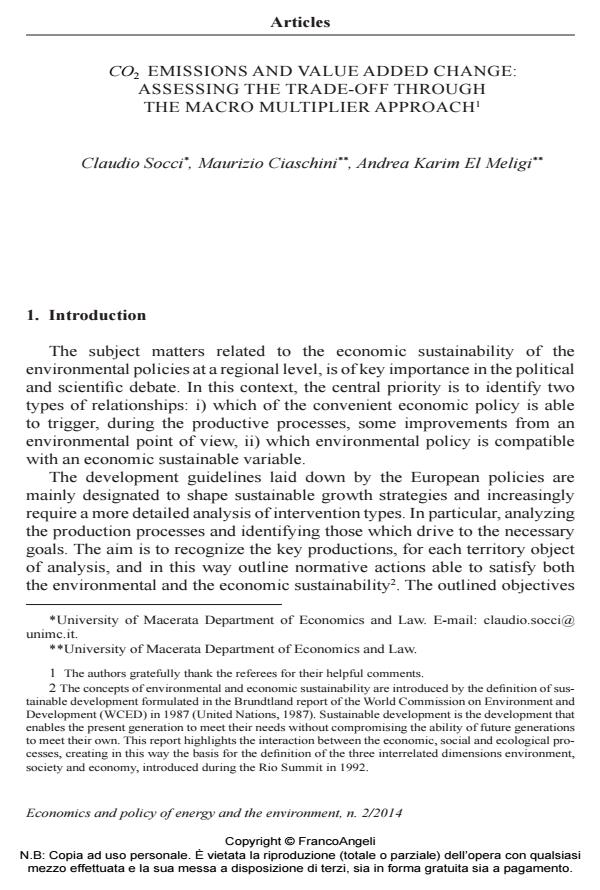CO2 emissions and value added change: assessing the trade-off through the macro multiplier approach
Titolo Rivista ECONOMICS AND POLICY OF ENERGY AND THE ENVIRONMENT
Autori/Curatori Claudio Socci, Maurizio Ciaschini, Andrea Karim El Meligi
Anno di pubblicazione 2015 Fascicolo 2014/2 Lingua Inglese
Numero pagine 26 P. 49-74 Dimensione file 383 KB
DOI 10.3280/EFE2014-002004
Il DOI è il codice a barre della proprietà intellettuale: per saperne di più
clicca qui
Qui sotto puoi vedere in anteprima la prima pagina di questo articolo.
Se questo articolo ti interessa, lo puoi acquistare (e scaricare in formato pdf) seguendo le facili indicazioni per acquistare il download credit. Acquista Download Credits per scaricare questo Articolo in formato PDF

FrancoAngeli è membro della Publishers International Linking Association, Inc (PILA)associazione indipendente e non profit per facilitare (attraverso i servizi tecnologici implementati da CrossRef.org) l’accesso degli studiosi ai contenuti digitali nelle pubblicazioni professionali e scientifiche
Recently, political and scientific debate is strongly focused on issues questioning the economic sustainability of environmental policies at regional level. Following European directives and protocols and in accordance with the principles of sustainable development, the interventions designed by policy makers are required to aim at restructuring the final emissions. In this paper an effort is made to assess a new structure for the final demand which would be able to achieve a composite task: the economic sustainability and the environmental improvement. In this respect, the regional Social Accounting Matrix (SAM), referred to a typical region of the Mediterranean area, the Sardinia, will be integrated with the environmental accounting scheme in order to develop the regional multisectoral extended model. The resulting inverse matrix will be used to identify which composition of the final demand (policy control variable) is consistent with the complex emissions together with a positive variation of the aggregate total output (policy target variable). For this purpose the Macro Multipliers approach, through the use of a bidimensional decision-making index, will allow us to identify the convenient structures for both economic and environmental target and assessing the expected negative trade-off.
Keywords:Environmental policy, multisectoral extended model, macro multipliers approach
Jel codes:D58, E16, H20, H76
- Ciaschini M., Pretaroli R., Severini F., Socci C., forthcoming. Policies for electricity production from renewable sources: the italian case. Journal of Policy Modeling, Elsevier.
- Ciaschini M., Pretaroli R., Socci C. (2009). Multisectoral structures and policy design. International Journal of Control (iFirst), 1-16.
- Ciaschini M., Pretaroli R., Socci C. (2011). Balance, Manhattan norm and Euclidean distance of industrial policies for the US. Structural Change and Economic Dynamics review. Elsevier, 22(3), 204-226.
- Ciaschini M., Socci C. (2006). Income distribution and output change: Macro multiplier approach. In: Salvadori, N. (Ed.). Economic Growth and Distribution: On the Nature and Cause of the Wealth of Nations. Edward Elgar.
- Ciaschini M., Socci C. (2007). Bi-regional SAM linkages: a modified backward and forward dispersion approach. Reviews of Urban and Regional Development Studies, 19(3), 233-254.
- European Commission, 23.4.2009. On the effort of member states to reduce their greenhouse gas emissions to meet the community’s greenhouse gas emission reduction commitments up to 2020. Official Journal of the European Union, decision No 406/2009/EC of the European Parliament and of the Council. European Commission, 3.3.2010. Europe 2020: A European strategy for smart, sustainable and inclusive growth. Communication from the Commission, COM(2010) 2020.
- European Commission, 26.1.2011. A resource-efficient Europe - flagship initiative under the Europe 2020 strategy. Communication from the Commission to the European Parliament, the Council, the European Commission and Social Committee and the Committee of the Regions, COM(2011) 21.
- Lancaster P., Tiesmenetsky M. (1985). The Theory of Matrices, 2nd Edition. Academic Press, New York.
- Lenzen M., Schaeffer R. (2004). Environmental and social accounting for Brazil. Environmental and Resource Economics, 2 (27), 201-226.
- Miller R., Blair P. (1985). Input-Output Analysis: Foundations and Extensions. Prentice-Hall, Inc., Englewood Cliffs, New Jersey.
- Miyazawa K. (1976). Input-Output Analysis and the Structure of Income Distribution. Vol. 116. Notes in Economics and Mathematical Systems. Heidelberg, Springer.
- Morilla C., Diaz-Salazar G., Cardenete M. (2007). Economic and environmental efficiency using a social accounting matrix. Ecological Economics, (60), 774-786.
- Musu I., Siniscalco D., (1996). National Accounts and the Environment. Dordrecht Netherlands, Kluwer Academic Publishers. Odum H. T. (1971). Environment, Power and Society. New York, Wiley-Interscience.
- Resosudarmo B. P., Thorbecke E. (1996). The impact of environmental policies on households incomes for different socio-economic classes: the case of air pollutants in Indonesia. Ecological Economics, (17), 83-94.
- Round J. (1985). Decomposing multipliers for the economic system involving regional and world trade. Economic Journal, 95, 383-399.
- Sardegna Statistiche (2012). Obiettivi Europa 2020 e indicatori di posizione della Sardegna e dell’Italia. Regione Autonoma della Sardegna.
- United Nations (1987). Report of the world commission on environment and development: Our common future.
- United Nations (1994). System of National Accounts. United Nations, New York.
Claudio Socci, Maurizio Ciaschini, Andrea Karim El Meligi, CO2 emissions and value added change: assessing the trade-off through the macro multiplier approach in "ECONOMICS AND POLICY OF ENERGY AND THE ENVIRONMENT" 2/2014, pp 49-74, DOI: 10.3280/EFE2014-002004